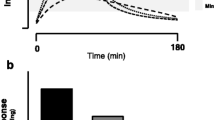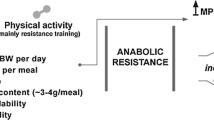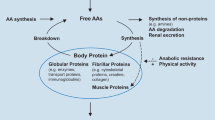Abstract
Dietary proteins/essential amino acids (EAAs) are nutrients with anabolic properties that may increase muscle mass or attenuate muscle loss during immobilization and aging via the stimulation of muscle protein synthesis (MPS). An EAA’s anabolic threshold, capable to maximize the stimulation of MPS has been hypothesized, but during certain conditions associated with muscle loss, this anabolic threshold seems to increase which reduces the efficacy of dietary EAAs to stimulate MPS. Preliminary studies have demonstrated that acute ingestion of dietary proteins/EAA (with a sufficient amount of leucine) was capable to restore the postprandial MPS during bed rest, immobilization or aging; however, whether these improvements translate into chronic increases (or attenuates loss) of muscle mass is equivocal. For example, although free leucine supplementation acutely increases MPS and muscle mass in some chronic studies, other studies have reported no increases in muscle mass following chronic leucine supplementation. In contrast, chronically increasing leucine intake via the consumption of an overall increase in dietary protein appears to be the most effective dietary intervention toward increasing or attenuating lean mass during aging; however, more research investigating the optimal dose and timing of protein ingestion is necessary. Several studies have demonstrated that decreases in postprandial MPS as a result of increased circulating oxidative and inflammatory are more responsible than muscle protein breakdown for the decreases in muscle mass during disuse and health aging. Therefore, nutritional interventions that reduce oxidation or inflammation in conjunction with higher protein intakes that overcome the anabolic resistance may enhance the MPS response to feeding and either increase muscle mass or attenuate loss. In preliminary studies, antioxidant vitamins and amino acids with antioxidant or anti-inflammatory properties show potential to restore the anabolic response associated with protein ingestion. More research, however, is required to investigate if these nutrients translate to increases in MPS and, ultimately, increased lean mass in aging humans. The purpose of the present review is to discuss the role of protein/EAA intake to enhance postprandial MPS during conditions associated with muscle loss, and bring new perspectives and challenges associated nutritional interventions aimed to optimize the anabolic effects of dietary protein/EAAs ingestion.

Similar content being viewed by others
References
Abdali D, Samson SE, Grover AK (2015) How effective are antioxidant supplements in obesity and diabetes? Med Princ Pract 24(3):201–215
Antonio J, Ellerbroek A, Silver T, Orris S, Scheiner M, Gonzalez A, Peacock CA (2015) A high protein diet (3.4 g/kg/day) combined with a heavy resistance training program improves body composition in healthy trained men and women: a follow-up investigation. J Int Soc Sports Nutr 12:39
Apicella JM, Lee EC, Bailey BL, Saenz C, Anderson JM, Craig S, Kraemer W, Volek J, Maresh CM (2012) Betaine supplementation enhances anabolic endocrine and Akt signaling in response to acute bouts of exercise. Eur J Appl Physiol 113(3):793–802
Atherton PJ, Smith K (2012) Muscle protein synthesis in response to nutrition and exercise. J Physiol 590(5):1049–1057
Atherton PJ, Greenhaff PL, Phillips SM, Bodine SC, Adams CM, Lang CH (2016) Control of skeletal muscle atrophy in response to disuse: clinical/preclinical contentions and fallacies of evidence. Am J Physiol Endocrinol Metab 311(3):E594–604. doi:10.1152/ajpendo.00257.2016
Baehr LM, West DW, Marcotte G, Marshall AG, De Sousa LG, Baar K, Bodine SC (2016) Age-related deficits in skeletal muscle recovery following disuse are associated with neuromuscular junction instability and ER stress, not impaired protein synthesis. Aging (Albany NY) 8:127–146
Balage M, Averous J, Remond D, Bos C, Pujos-Guillot E, Papet I, Mosoni L, Combaret L, Dardevet D (2010) Presence of low-grade inflammation impaired postprandial stimulation of muscle protein synthesis in old rats. J Nutr Biochem 21:325–331
Bauer J, Biolo G, Cederholm T, Cesari M, Cruz-Jentoft AJ, Morley JE, Phillips S, Sieber C, Stehle P, Teta D et al (2013) Evidence-based recommendations for optimal dietary protein intake in older people: a position paper from the PROT-AGE Study Group. J Am Med Dir Assoc 14:542–559
Breen L, Churchward-Venne TA (2012) Leucine: a nutrient 'trigger' for muscle anabolism, but what more? J Physiol 590(9):2065–2066. doi:10.1113/jphysiol.2012.230631
Breen L, Stokes KA, Churchward-Venne TA, Moore DR, Baker SK, Smith K, Atherton PJ, Phillips SM (2013) Two weeks of reduced activity decreases leg lean mass and induces ‘anabolic resistance’ of myofibrillar protein synthesis in healthy elderly. J Clin Endocrinol Metab 98:2604–2612
Brocca L, Cannavino J, Coletto L, Biolo G, Sandri M, Bottinelli R, Pellegrino MA (2012) The time course of the adaptations of human muscle proteome to bed rest and the underlying mechanisms. J Physiol 590(Pt 20):5211–5230
Cholewa JM, Wyszczelska-Rokiel M, Glowacki R, Jakubowski H, Matthews T, Wood R, Craig S, Paolone V (2013) Effects of betaine on body composition, performance, and homocysteine thiolactone. J Int Soc Sports Nutr 10(1):39
Cholewa JM, Guimarães-Ferreira L, Zanchi NE (2014) Effects of betaine on performance and body composition: a review of recent findings and potential mechanisms. Amino Acids 46(8):1785–1793
Crossland H, Constantin-Teodosiu D, Gardiner SM, Constantin D, Greenhaff PL (2008) A potential role for Akt/FOXO signalling in both protein loss and the impairment of muscle carbohydrate oxidation during sepsis in rodent skeletal muscle. J Physiol 586:5589–5600. doi:10.1113/jphysiol.2008.160150
Crossland H, Constantin-Teodosiu D, Greenhaff PL, Gardiner SM (2010) Low-dose dexamethasone prevents endotoxaemia-induced muscle protein loss and impairment of carbohydrate oxidation in rat skeletal muscle. J Physiol 588:1333–1347
Cruz-Jentoft AJ, Baeyens JP, Bauer JM, Boirie Y, Cederholm T, Landi F, Martin FC, Michel JP, Rolland Y, Schneider SM, Topinková E, Vandewoude M, Zamboni M; European Working Group on Sarcopenia in Older People (2010) Sarcopenia: European consensus on definition and diagnosis: Report of the European Working Group on Sarcopenia in Older People. Age Ageing 39(4):412–423. doi:10.1093/ageing/afq034
Cuthbertson D, Smith K, Babraj J, Leese G, Waddell T, Atherton P, Wackerhage H, Taylor PM, Rennie MJ (2005) Anabolic signaling deficits underlie amino acid resistance of wasting, aging muscle. FASEB J 19:422–424
Dardevet D, Sornet C, Balage M, Grizard J (2000) Stimulation of in vitro rat muscle protein synthesis by leucine decreases with age. J Nutr 130:2630–2635
Dardevet D, Remond D, Peyron MA, Papet I, Savary-Auzeloux I, Mosoni L (2012) Muscle wasting and resistance of muscle anabolism: the “anabolic threshold concept” for adapted nutritional strategies during sarcopenia. Sci World J 2012:269531
Detopoulou P, Panagiotakos DB, Antonopoulou S, Pitsavos C, Stefanadis C (2008) Dietary choline and betaine intakes in relation to concentrations of inflammatory markers in healthy adults: the ATTICA study. Am J Clin Nutr 87(2):424–430
Dickinson JM, Drummond MJ, Coben JR, Volpi E, Rasmussen BB (2013) Aging differentially affects human skeletal muscle amino acid transporter expression when essential amino acids are ingested after exercise. Clin Nutr. 32(2):273–280
Dowling JJ, Arbogast S, Hur J, Nelson DD, McEvoy A, Waugh T, Marty I, Lunardi J, Brooks SV, Kuwada JY, Ferreiro A (2012) Oxidative stress and successful antioxidant treatment in models of RYR1-related myopathy. Brain 135(4):1115–1127
Drummond MJ, Fry CS, Glynn EL, Timmerman KL, Dickinson JM, Walker DK, Gundermann DM, Volpi E (1985) Rasmussen BB (2011) Skeletal muscle amino acid transporter expression is increased in young and older adults following resistance exercise. J Appl Physiol 111(1):135–142
Drummond MJ, Dickinson JM, Fry CS, Walker DK, Gundermann DM, Reidy PT, Timmerman KL, Markofski MM, Paddon-Jones D, Rasmussen BB, Volpi E (2012) Bed rest impairs skeletal muscle amino acid transporter expression, mTORC1 signaling, and protein synthesis in response to essential amino acids in older adults. Am J Physiol Endocrinol Metab 302(9):E1113–E1122
English KL, Mettler JA, Ellison JB, Mamerow MM, Arentson-Lantz E, Pattarini JM, Ploutz-Snyder R, Sheffield-Moore M, Paddon-Jones D (2016) Leucine partially protects muscle mass and function during bed rest in middle-aged adults. Am J Clin Nutr 103(2):465–473
Evans K, Nasim Z, Brown J, Butler H, Kauser S, Varoqui H, Erickson JD, Herbert TP, Bevington A (2007) Acidosis-sensing glutamine pump SNAT2 determines amino acid levels and mammalian target of rapamycin signalling to protein synthesis in L6 muscle cells. J Am Soc Nephrol 18(5):1426–1436
Farid M, Reid MB, Li YP, Gerken E, Durham WJ (2005) Effects of dietary curcumin or N-acetylcysteine on NF-kappaB activity and contractile performance in ambulatory and unloaded murine soleus. Nutr Metab (Lond) 26(2):20
Ferrando AA, Paddon-Jones D, Hays NP, Kortebein P, Ronsen O, Williams RH, McComb A, Symons TB, Wolfe RR, Evans W (2010) EAA supplementation to increase nitrogen intake improves muscle function during bed rest in the elderly. Clinl Nutr 29:18–23
Frost RA, Lang CH (2011) mTor signaling in skeletal muscle during sepsis and inflammation: where does it all go wrong? Physiol (Bethesda) 26:83–96
Fuster G, Busquets S, Ametller E, Olivan M, Almendro V, de Oliveira CC, Figueras M, López-Soriano FJ, Argilés JM (2007) Are peroxisome proliferator-activated receptors involved in skeletal muscle wasting during experimental cancer cachexia? Role of beta2-adrenergic agonists. Cancer Res 67(13):6512–6519
Gibson JN, Halliday D, Morrison WL, Stoward PJ, Hornsby GA, Watt PW, Murdoch G, Rennie MJ (1987) Decrease in human quadriceps muscle protein turnover consequent upon leg immobilization. Clin Sci (Lond) 72(4):503–509
Glover EI, Phillips SM, Oates BR, Tang JE, Tarnopolsky MA, Selby A, Smith K, Rennie MJ (2008) Immobilization induces anabolic resistance in human myofibrillar protein synthesis with low and high dose amino acid infusion. J Physiol 586(24):6049–6061
Glover EI, Phillips SM, Oates BR, Tang JE, Tarnopolsky MA, Selby A, Smith K, Rennie MJ (2009) Immobilization induces anabolic resistance in human myofibrillar protein synthesis with low and high dose amino acid infusion. J Physiol 586:6049–6061
Guimarães-Ferreira L, Cholewa JM, Naimo MA, Zhi XI, Magagnin D, de Sá RB, Streck EL, Teixeira Tda S, Zanchi NE (2014) Synergistic effects of resistance training and protein intake: practical aspects. Nutrition 30(10):1097–1103
Ham DJ, Murphy KT, Chee A, Lynch GS, Koopman R (2014) Glycine administration attenuates skeletal muscle wasting in a mouse model of cancer cachexia. Clin Nutr 33:448–458
Ham DJ, Caldow MK, Chhen V, Chee A, Wang X, Proud CG, Lynch GS, Koopman R (2016) Glycine restores the anabolic response to leucine in a mouse model of acute inflammation. Am J Physiol Endocrinol Metab 310(11):E970–E981
Hamburg NM, McMackin CJ, Huang AL, Shenouda SM, Widlansky ME, Schulz E, Gokce N, Ruderman NB, Keaney JF Jr, Vita JA (2007) Physical inactivity rapidly induces insulin resistance and microvascular dysfunction in healthy volunteers. Arterioscler Thromb Vasc Biol 27(12):2650–2656
Harlow HJ, TD Lohuis, TDI Beck, PA Iaizzo (2001) Muscle strength in overwintering bears. Nature 409:997
Janssen I (2011) The epidemiology of sarcopenia. Clin Geriatr Med 27(3):355–363. doi:10.1016/j.cger.2011.03.004
Katsanos CS, Kobayashi H, Sheffield-Moore M, Aarsland A, Wolfe RR (2006) A high proportion of leucine is required for optimal stimulation of the rate of muscle protein synthesis by essential amino acids in the elderly. Am J Physiol Endocrinol Metab 291(2):381–387
Kim TN, Choi KM (2013) Sarcopenia: definition, epidemiology, and pathophysiology. J Bone Metab 20(1):1–10
Knudsen A, Lervik L, Harvey S, Løvvik C, Omenås A, Mykletun A (2012) Comparison of chronic fatigue syndrome/myalgic encephalopathy with other disorders: an observational study. JRSM Short Rep 3(5):32. doi:10.1258/shorts.2011.011167
Krawiec BJ, Frost RA, Vary TC, Jefferson LS, Lang CH (2005) Hindlimb casting decreases muscle mass in part by proteasome-dependent proteolysis but independent of protein synthesis. Am J Physiol Endocrinol Metab 289(6):E969–980
Krogh-Madsen R, Thyfault JP, Broholm C, Mortensen OH, Olsen RH, Mounier R, Plomgaard P, van Hall G, Booth FW, Pedersen BK (2010) A 2-wk reduction of ambulatory activity attenuates peripheral insulin sensitivity. J Appl Physiol 108(5):1034. doi:10.1152/japplphysiol.00977.2009
Lee EK, Janga EJ, Jungb KJ, Kima DH, Yu BP, Chunga HY (2013) Betaine attenuates lysophosphatidylcholine-mediated adhesion molecules in aged rat aorta: Modulation of the nuclear factor-κB pathway. Exp Gerontol 48(5):517–524
Li X, Zhao Q, Liao R, Sun P, Wu X (2003) The SCF(Skp2) ubiquitin ligase complex interacts with the human replication licensing factor Cdt1 and regulates Cdt1 degradation. J Biol Chem 278(33):30854–30858
Marzani B, Balage M, Vénien A, Astruc T, Papet I, Dardevet D, Mosoni L (2008) Antioxidant supplementation restores defective leucine stimulation of protein synthesis in skeletal muscle from old rats. J Nutr 138(11):2205–2211
May RC, Piepenbrock N, Kelly RA, Mitch WE (1991) Leucine-induced amino acid antagonism in rats: muscle valine metabolism and growth impairment. J Nutr 121(3):293–301
McDonald CK, Ankarfeldt MZ, Capra S, Bauer J, Raymond K, Heitmann BL (2016) Lean body mass change over 6 years is associated with dietary leucine intake in an older Danish population. Br J Nutr 115(9):1556–1562
Moore DR, Churchward-Venne TA, Witard O, Breen L, Burd NA, Tipton KD, Phillips SM (2015) Protein ingestion to stimulate myofibrillar protein synthesis requires greater relative protein intakes in healthy older versus younger men. J Gerontol A Biol Sci Med Sci 70:57–62
Murphy CH, Saddler NI, Devries MC, McGlory C, Baker SK, Phillips SM (2016) Leucine supplementation enhances integrative myofibrillar protein synthesis in free-living older men consuming lower- and higher-protein diets: a parallel-group crossover study. Am J Clin Nutr 104(6):1594–1606
Najib S, Sánchez-Margalet V (2005) Homocysteine thiolactone inhibits insulin-stimulated DNA and protein synthesis: possible role of mitogen-activated protein kinase (MAPK), glycogen synthase kinase-3 (GSK-3) and p70 S6K phosphorylation. J Mol Endocrinol 34(1):119–126
Norton C, Toomey C, McCormack WG, Francis P, Saunders J, Kerin E, Jakeman P (2016) Protein supplementation at breakfast and lunch for 24 weeks beyond habitual intakes increases whole-body lean tissue mass in healthy older adults. J Nutr 146(1):65–69. doi:10.3945/jn.115.219022
Olsen RH, Krogh-Madsen R, Thomsen C, Booth FW, Pedersen BK (2008) Metabolic responses to reduced daily steps in healthy nonexercising men. JAMA 299: 1261–1263
Paddon-Jones D, Rasmussen BB (2009) Dietary protein recommendations and the prevention of sarcopenia. Curr Opin Clin Nutr Metab Care 12:86–90
Park SB, Georgiades A (2013) Changes in Body Composition Predict Homocysteine Changes and Hyperhomocysteinemia in Korea. J Korean Med Sci 28(7):1015–1020
Phillips SM, Glover EI, Rennie MJ (2009) Alterations of protein turnover underlying disuse atrophy in human skeletal muscle. J Appl Physiol 107(3):645–654
Powers ET, Morimoto RI, Dillin A, Kelly JW, Balch WE (2009) Biological and chemical approaches to diseases of proteostasis deficiency. Annu Rev Biochem 78:959–991
Rieu I, Sornet C, Bayle G, Prugnaud J, Pouyet C, Balage M, Papet I, Grizard J, Dardevet D (2003) Leucine-supplemented meal feeding for ten days beneficially affects postprandial muscle protein synthesis in old rats. J Nutr 133:1198–1205
Rieu I, Balage M, Sorneta C, Debrasa E, Ripesa S, Rochon-Bonhomme C, Pouyeta C, Grizard J, Dardevet D (2007) Increased availability of leucine with leucine-rich whey proteins improves postprandial muscle protein synthesis in aging rats. Nutrition 23:323–331
Santilli F, Lapenna D, La Barba S, Davì G (2014) Oxidative stress-related mechanisms affecting response to aspirin in diabetes mellitus. Free Radic Biol Med 80:101–110. doi:10.1016/j.freeradbiomed.2014.12.010
Savary-Auzeloux I, Magne H, Migné C, Oberli M, Breuillé D, Faure M, Vidal K, Perrot M, Rémond D, Combaret L, Dardevet D (2013) A dietary supplementation with leucine and antioxidants is capable to accelerate muscle mass recovery after immobilization in adult rats. PLoS One 8(11):e81495
Tang JE, Phillips SM (2009) Maximizing muscle protein anabolism: the role of protein quality. Curr Opin Clin Nutr Metab Care 12(1):66–71
Toth MJ, Matthews DE, Tracy RP, Previs MJ (2005) Age-related differences in skeletal muscle protein synthesis: relation to markers of immune activation. Am J Physiol Endocrinol Metab 288(5):E883–E891
Trappe S, Creer A, Slivka D, Minchev K, Trappe T (2007a) Single muscle fiber function with concurrent exercise or nutrition countermeasures during 60 days of bed rest in women. J Appl Physiol (1985) 103(4):1242–1250
Trappe TA, Burd NA, Louis ES, Lee GA, Trappe SW (2007b) Influence of concurrent exercise or nutrition countermeasures on thigh and calf muscle size and function during 60 days of bed rest in women. Acta Physiol 2:147–159
Trappe S, Creer A, Minchev K, Slivka D, Louis E, Luden N, Trappe T (2008) Human soleus single muscle fiber function with exercise or nutrition countermeasures during 60 days of bed rest. Am J Physiol Regul Integr Comp Physiol 294(3):R939–R947
Tse H, Tseng C (2014) Update on the pathological processes, molecular biology, and clinical utility of N-acetylcysteine in chronic obstructive pulmonary disease. Int J Chron Obstruct Pulmon Dis 9:825–836
Veeranki V, Lominadze D, Tyagi SC (2015) Hyperhomocysteinemia inhibits satellite cell regenerative capacity through p38 alpha/beta MAPK signaling. Am J Physiol Heart Circ Physiol 309(2):H325–H334
Verhoeven S, Vanschoonbeek K, Verdijk LB, Koopman R, Wodzig WK, Dendale P, van Loon LJ (2009) Long-term leucine supplementation does not increase muscle mass or strength in healthy elderly men. Am J Clin Nutr 89(5):1468–1475. doi:10.3945/ajcn.2008.26668
Wall BT, Snijders T, Senden JM, Ottenbros CL, Gijsen AP, Verdijk LB, van Loon LJ (2013) Disuse impairs the muscle protein synthetic response to protein ingestion in healthy men. J Clin Endocrinol Metab 98:4872–4881
Wang X, Hu Z, Hu J, Du J, Mitch WE (2006) Insulin resistance accelerates muscle protein degradation: activation of the ubiquitin-proteasome pathway by defects in muscle cell signaling. Endocrinology 147(9):4160–4168
Wang WW, Wu ZL, Dai ZL, Yang Y, Wang JJ, Wu G (2013) Glycine metabolism in animals and humans: implications for nutrition and health. Amino Acids 45:463–477
Zafarullah M, Li WQ, Sylvester J, Ahmad M (2003) Molecular mechanisms of N-acetylcysteine actions. Cell Mol Life Sci 60(1):6–20
Zhong Z, Wheeler MD, Li X, Froh M, Schemmer P, Yin M, Bunzendaul H, Bradford B, Lemasters JJ (2003) l-Glycine: a novel antiinflammatory, immunomodulatory, and cytoprotective agent. Curr Opin Clin Nutr Metab Care 6:229–240
Author information
Authors and Affiliations
Corresponding author
Ethics declarations
Conflict of interest
We have no conflict of interest to declare.
Rights and permissions
About this article
Cite this article
Cholewa, J.M., Dardevet, D., Lima-Soares, F. et al. Dietary proteins and amino acids in the control of the muscle mass during immobilization and aging: role of the MPS response. Amino Acids 49, 811–820 (2017). https://doi.org/10.1007/s00726-017-2390-9
Received:
Accepted:
Published:
Issue Date:
DOI: https://doi.org/10.1007/s00726-017-2390-9




